Category:
General News
The Anniversary of the Death of a Man Who Changed Warfare Forever
Notice: Use of undefined constant the_post_thumbnail - assumed 'the_post_thumbnail' in /home/netscrib/public_html/civilwarcavalry/wp-content/themes/wittenberg/archive.php on line 65

Today is the 166th anniversary of the death of British officer Henry Shrapnel, the inventor of the long-range artillery shell that bears his name.
Here’s an interesting article about him that appeared on Wired.com today:
March 13, 1842: Henry Shrapnel Dies, But His Name Lives On
By Tony Long 03.13.08 | 12:00 AM1842: Henry Shrapnel, inventor of the long-range artillery shell that bears his name, dies.
Shrapnel, a British lieutenant, was serving in the Royal Artillery when he perfected his shell in the mid-1780s. A shrapnel shell, unlike a conventional high-explosive artillery round, is designed as an anti-personnel weapon. The projectile is packed with fragments — often sharp metal, lead balls or nails — and detonates in midair, spraying enemy troops in the vicinity with what the British quickly christened “shrapnel.”
In developing his shell, Shrapnel married two existing weapons technologies, the canister shot and the delayed-action fuse. Canister shot, in use since the 1400s, burst upon leaving the gun’s muzzle and was originally used in small arms at close range against infantry. Shrapnel’s refinement carried the shell intact to the enemy’s lines, where it detonated above the heads of the troops with much more devastating effect.
The British army, not quick to embrace innovation, did not adopt Shrapnel’s invention until 1803. It saw early action against the Dutch in Suriname but really came into its own after the Duke of Wellington demonstrated its effectiveness against Napoleon’s army at several engagements, including the Battle of Waterloo.
Henry Shrapnel, by then a captain, was rewarded with a promotion to major and soon thereafter to lieutenant colonel. In 1814, the British government awarded him a lifetime annual stipend of 1,200 pounds (about $128,000 in today’s money). Later, as inspector of artillery, Shrapnel also worked on improvements in howitzers and mortars. He ended his military career a major general.
The shrapnel shell was quickly adopted by the armies of all Europe’s great powers. Armorers across the continent tinkered with the design, mainly looking for ways to improve range, but Shrapnel’s original principle remained the basic blueprint through the end of World War I. By then, shrapnel shells could be hurled 6,000 yards and were being used in a variety of situations, including close infantry support.
By World War II, the day of Henry Shrapnel’s shell was over, although variants saw action throughout that war, as well as in Korea and Vietnam. Modern arsenals still employ shells that use canister-shot projectiles based on the original shrapnel principle, but the nature of ordnance has obviously changed.
As for the word itself, shrapnel has long been used generically to refer to any shell fragment.
Shrapnel’s invention certainly impacted the American Civil War and forever changed the way that artillery would be used.
Scridb filterWhite Death From Above
Notice: Use of undefined constant the_post_thumbnail - assumed 'the_post_thumbnail' in /home/netscrib/public_html/civilwarcavalry/wp-content/themes/wittenberg/archive.php on line 65

Because of its geographic location, Columbus typically does not get big snow storms. What usually happens is that it will start out as snow and then switch over to sleet or freezing rain (what I generally describe as slop) and sometimes to just plain rain. We’re usually just a little too far east to get all snow and a little too far west to get all rain. Here’s a good example. In December 2003, just a couple of days before Christmas, we had a storm that started out as snow–about 8 inches–and then turned to freezing rain. When it was all said and done we had 2.5 inches of ice on top of the snow and no power for nearly four days. The rain/snow line was about 20 miles west of us.
For a change, this time, the storm went right up the spine of the Appalachians, meaning that the rain/snow line is about 75 miles east of Columbus. The White Death From Above began falling yesterday morning about 9:00 and came down steadily until about 7:00 P.M. We had five or six inches of snow and then it stopped for a few hours before phase two of the storm came along during the night.
As I write this, we’ve had at least a foot of the White Death From Above, and we’re under a blizzard warning for the rest of the day. We’re looking at another several inches of the White Death before it ends. This is, without question, the biggest single snowfall that has occurred in the 20+ years that I have lived here in Columbus. Pretty much everything in our county is shut down at this point and they’re trying to keep people off the roads. Watching the dogs trying to negotiate their way through the White Death is quite humorous.


The snowdog laying down is Aurora. She’s two. The one running through the snow is Nero, who’s three. They’re loving this stuff.
I’ve had quite enough of the White Death From Above and am eager for spring to come. Of course, with it being March, it’s supposed to be 50 on Tuesday, meaning that all of this will turn to slop in no time flat. Spring cannot come soon enough.
UPDATE, 12:30 PM: I just was out in the yard with the dogs–I made the mistake of throwing one of their toys out there, and it was a real challenge getting them back in the house with the toy–and we’ve probably got 14-16 inches of White Death in the backyard. And it’s the dry, light, fluffy stuff. Like I said, spring cannot come soon enough.
UPDATE, 6:15 PM: The White Death From Above finally seems to be tapering to an end. We have approximately 18 inches of the stuff here at our house. The official records are set at Port Columbus International Airport, and the airport marked 20 inches of total snowfall, shattering the all-time record for a single storm since records have been kept here. We’ve now got blowing and drifting. Lots of fun. I hereby vote that the rest of winter be canceled due to lack of interest.

This photo is looking down my driveway at the street. You can’t tell where the driveway ends and the grass begins because it’s under more than a foot and a half of snow.
Scridb filterUpdate
Notice: Use of undefined constant the_post_thumbnail - assumed 'the_post_thumbnail' in /home/netscrib/public_html/civilwarcavalry/wp-content/themes/wittenberg/archive.php on line 65

It has now been six weeks since I sent my letter to Governor Ted Strickland of Ohio, inquiring as to what the state intended to do to commemorate the 150th anniversary of the Civil War. Sadly, and as I actually expected, I have gotten absolutely no response. That just verifies what I had suspected all along, which is that Ohio is pretty much a historical wasteland.
I wish I could say that I am surprised by the lack of a response, but I can’t.
Scridb filterDamned Bad Luck
Notice: Use of undefined constant the_post_thumbnail - assumed 'the_post_thumbnail' in /home/netscrib/public_html/civilwarcavalry/wp-content/themes/wittenberg/archive.php on line 65

Now this is a prime example of damned bad luck….
Civil War buff killed in blast blamed on antique munitions
By Associated Press
Tuesday, February 19, 2008 – Updated 1h agoRICHMOND, Va. – A man who sold Civil War relics that included munitions was killed by an explosion, and residents of the neighborhood were kept out of their homes today as experts looked for more explosives.
Samuel H. White, 53, was found in his backyard Monday by neighbors who had heard the blast, Chesterfield County police said.
Police Capt. Steve Neal said that what exploded was military ordnance, possibly dating from the Civil War. Authorities found unexploded military ordnance at his house, and on Tuesday they were still collecting and detonating explosives.
White’s business, Sam White Relics, advertised various relics for sale including Civil War artillery shells, cannonballs and bullets. His Web site says he would “disarm, clean, and preserve your Civil War period and earlier military ordnance” for about $35 each.
About two dozen nearby homes were evacuated as a precaution and police spokeswoman Ann Reid said the evacuation would remain in effect indefinitely.
Neighbor Brian Dunkerly told the Richmond Times-Dispatch the explosion hurled a chunk of metal weighing about 15 pounds that struck the roof of his front porch about one-quarter-mile from White’s house. He said no one was hurt, although the piece of metal shattered his glass front door, hit the floor inside and bounced to the ceiling before coming to rest in the center of his living room.
I guess that’s a guy who died doing something he loved…..
Hat tip to Dan Mallock for bringing this to my attention.
Scridb filterOne day trip to Richmond, VA
Notice: Use of undefined constant the_post_thumbnail - assumed 'the_post_thumbnail' in /home/netscrib/public_html/civilwarcavalry/wp-content/themes/wittenberg/archive.php on line 65

Susan and I got up yesterday morning at the ungodly hour of 4:00 a.m. to catch a flight to Richmond. I was invited to be the speaker at the commemoration of the anniversary of Jeb Stuart’s birth by the Stuart-Mosby Historical Society. There was a commemoration at Stuart’s grave in Hollywood Cemetery, and then a luncheon at a lovely place called the Commonwealth Club. Susan did a good job of acting as photographer; these are her photos. Fortunately, it was 67 degrees in Richmond yesterday, and it was really nice being able to walk around without a coat in early February.
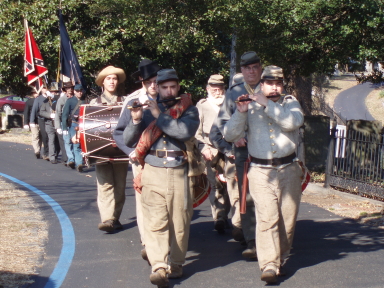
Detachments of two different reenacting groups provided honor guards. One was a fife and drum corps and the other a regimental color guard. Both were quite authentic, and both did a fine job.
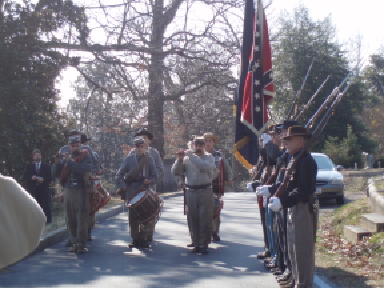
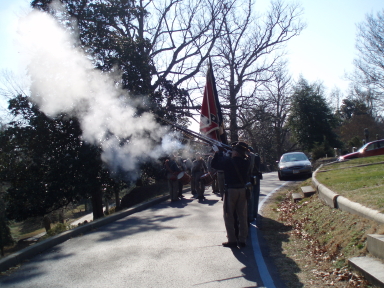
I’m told that there’s usually a cannon at the commemoration, but that they could not make it at the last moment. Instead, the color guard fired three volleys in General Stuart’s honor.
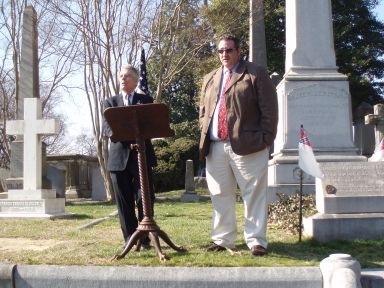
I found out yesterday morning that not only was I to speak at the luncheon after the graveside ceremony, I was also expected to say a few words at the cemetery. I had no idea of this until about twenty minutes before it happened, so I had to wing it. I guess I did okay.
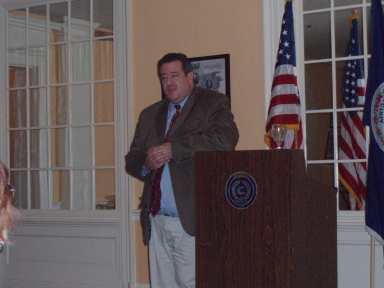
After a nice lunch, I gave the assembled members my rendition of the events covered in Plenty of Blame to Go Around: Jeb Stuart’s Controversial Ride to Gettysburg. I’m pretty sure I’m coming down with something, and my voice was pretty rough. I’m just glad it held out.
Last night, we had dinner at The Tobacco Company Restaurant in the Shockoe Slip district of Richmond with old friend Melissa Delcour, whom we haven’t seen in ages. We had a terrific dinner getting caught up with Melissa, and then it was to bed early to get up at 4:30 to make our return flight to Columbus this morning. We were gone for 26 hours, and it was chaotic. Thanks to Skybus, we were able to fly directly into Richmond for a very inexpensive airfare ($110 roundtrip for each of us) instead of all of that driving.
Needless to say, I’m not used to being up that early, let alone that early two days in a row. I suspect we’re all headed to bed early tonight……
What a Shame….
Notice: Use of undefined constant the_post_thumbnail - assumed 'the_post_thumbnail' in /home/netscrib/public_html/civilwarcavalry/wp-content/themes/wittenberg/archive.php on line 65

Hat tip to Rea Redd for bringing this sad story to my attention. It’s a shame that flogging is considered cruel and unusual punishment.
Man arrested in eBay sale of historic documents
Tue Jan 29, 2008NEW YORK (Reuters) – A New York state employee who had access to government-owned archives has been arrested on suspicion of stealing hundreds of historic documents, many of which he sold on eBay, authorities said on Monday.
Among the missing documents were an 1823 letter by U.S. Vice President John C. Calhoun and copies of the Davy Crockett Almanacs, pamphlets written by the frontiersman who died at the Alamo in Texas.
Daniel Lorello, 54, of Rensselaer, New York, was charged with grand larceny, possession of stolen property and fraud. He pleaded innocent in Albany City Court on Monday.
He was found out by an alert history buff who saw the items posted on the online auction site and alerted authorities, the state attorney general’s office said in a statement.
Lorello, a department of education archivist, pleaded not guilty to the charges although he previously admitted in a written statement to stealing documents and artifacts since 2002. The attorney general’s office released a copy of his statement.
In 2007 alone, Lorello stated he took 300 to 400 items, including the four-page Calhoun letter, which drew bids of more than $1,700 while investigators were monitoring the sale.
Officials recovered some 400 items from his upstate New York home, which Lorello estimated was 90 percent of everything he had taken, but they have yet to determine how many items were sold online.
Other items Lorello admitted in his statement to stealing and selling included an 1835 Davey Crockett Almanac, which fetched $3,200, and a Poor Richard’s Almanac which went for $1,001.
EBay was cooperating with state officials in the probe.
The real tragedy of this is that I actually know Dan Lorello. A number of years ago, when I was writing my book Little Phil, the issue of whether Phil Sheridan had been born in Albany, NY arose. I knew Dan from having him help me with getting materials from the papers of William Woods Averell for a prior book project, and I wanted to see what records there were of Sheridan’s possible birth in Albany, which is what Sheridan himself claimed. Dan did some digging for me and confirmed what I suspected, which is that no such records existed (for good reason–Sheridan was born in Ireland, and those records do, in fact, exist). Later, I wanted to include a photo of the equestrian monument to Sheridan that sits outside the state capitol building in Albany in the book, and Dan took that photo for me. In fact, the photo in the book is credited to him.
To say that I’m profoundly disappointed does not do it justice. I never would have guessed that Dan would be the sort to do this kind of thing, but then again, nobody ever really knows….
All I know is that Dan deserves whatever he gets in the way of punishment, and that whatever that might be, it’s not enough.
Scridb filterUpcoming Events
Notice: Use of undefined constant the_post_thumbnail - assumed 'the_post_thumbnail' in /home/netscrib/public_html/civilwarcavalry/wp-content/themes/wittenberg/archive.php on line 65

For those who might be interested, I wanted to announce a couple of upcoming events I’ve committed to attending.
First, I have accepted an invitation to be the keynote speaker at the commemoration of Jeb Stuart’s birthday in Richmond on February 9. The program is sponsored by the Stuart-Mosby Historical Society. The event begins at 11:00 with a wreath-laying ceremony at General Stuart’s grave in Hollywood Cemetery, and then there is a luncheon at the lovely downtown Commonwealth Club. I will be the lunchtime speaker, and will be doing a presentation on Stuart’s ride during the Gettysburg Campaign. Susan and I will be flying into Richmond that Saturday morning.
The other event I’ve committed to attending is my friend Mark Snell’s excellent annual summer conference of the George Tyler Moore Civil War Center at Shepherd University in Shepherdstown, West Virginia. This year’s program is Gettysburg Retreat and Pursuit, and will be held June 26-29. I’m kind of the star of the show in that I’ll be leading a half day tour of the route of the Wagon Train of Wounded and a full day tour of the fighting along the retreat route. Kent Masterson Brown will be on the program, as will old friends Ted Alexander and Tom Clemens. Mark runs a first-rate conference, and I was really excited when he asked me to participate.
For those interested in the retreat from Gettysburg and the pursuit of the Army of Northern Virginia, this will be a can’t-miss program.
I hope to see some of you at one or both of these events.
Scridb filterTour of Chickamauga
Notice: Use of undefined constant the_post_thumbnail - assumed 'the_post_thumbnail' in /home/netscrib/public_html/civilwarcavalry/wp-content/themes/wittenberg/archive.php on line 65

My friend Dave Powell, who does not maintain a blog of his own (but probably should), asked me to post this for him about a tour he will be leading at Chickamauga in March. It sounds like a great program, and if I didn’t already have stuff booked two weekends in March, I would probably go. Anyway, Dave asked that this be posted, so here goes:
Chickamauga Tour: Friday, March 14, and Saturday, March 15, 2008.
2008 Theme: Friday: Wilder’s Brigade; Saturday: Defending (and defining) Horseshoe Ridge.
Tour Leaders: Jim Ogden, Park Historian, and Dave Powell
All tours meet at the Visitor’s Center parking lot 15 minutes before scheduled start time.
Friday Morning: 8:30 a.m. to Noon. Wilder’s Brigade, September 11-17. 1863.
By Bus, we will trace the route of Wilder’s Brigade in the days leading up to the battle, including significant stops at Ringgold, Tunnel Hill, Leet’s Tanyard, and Lee and Gordon’s Mills.
Friday Afternoon: 1:30 p.m. to 5:00 p.m. Wilder’s Brigade, September 18-20, 1863.
By Bus, we will visit the various scenes of Wilder’s engagements on the field. Starting at Alexander’s Bridge, we will discuss screening operations, the retreat to Vinyard Field, the role of the Brigade there on September 19th, detached operations in Brotherton Field, and finish at Wilder Tower.
Saturday Morning: 8:30 a.m. to Noon. Benning and Robertson versus Brannan
On foot: We follow the Confederate attack through Poe Field and into North Dyer Field, ultimately to the foot of Snodgrass Ridge.
Saturday Afternoon: 1:30 p.m. to 5:00 p.m. Gracie’s Horseshoe Ridge, The battles of 1863 and 1896.
On Foot: Horseshoe Ridge provides a dramatic conclusion to the battle of Chickamauga.. We will discuss the actual fighting and positions of the units involved, as contrasted with where the monuments are placed today.
Cost: Beyond the fee for Friday’s Bus, there is no cost for tour participation. Meals lodging, transportation, and incidentals, however, are the individual’s responsibility. Dress in layers, and prepare for some walking. On Saturday, we will walk extensively.
Friday’s tours.
Pre-registration Fee: $35 Due by February 1st, 2008; send to:
FRANK CRAWFORD
34664 ORANGE DRIVE
PINELLAS PARK, FLORIDA 33781
Please also note that this fee is NON-REFUNDABLE after February 1st, 2008.
Walk-on Fee for Friday only: $40. Saturday walk-on, no charge.
Scridb filterWho Says the Civil War is Over?
Notice: Use of undefined constant the_post_thumbnail - assumed 'the_post_thumbnail' in /home/netscrib/public_html/civilwarcavalry/wp-content/themes/wittenberg/archive.php on line 65

Boy, politics truly do make for strange bedfellows. Have a look at this article, which appeared on Yahoo today:
Secessionists meeting in Tennessee By BILL POOVEY, Associated Press Writer
Wed Oct 3, 3:15 AM ET
CHATTANOOGA, Tenn. – In an unlikely marriage of desire to secede from the United States, two advocacy groups from opposite political traditions — New England and the South — are sitting down to talk.
Tired of foreign wars and what they consider right-wing courts, the Middlebury Institute wants liberal states like Vermont to be able to secede peacefully.
That sounds just fine to the League of the South, a conservative group that refuses to give up on Southern independence.
“We believe that an independent South, or Hawaii, Alaska, or Vermont would be better able to serve the interest of everybody, regardless of race or ethnicity,” said Michael Hill of Killen, Ala., president of the League of the South.
Separated by hundreds of miles and divergent political philosophies, the Middlebury Institute and the League of the South are hosting a two-day Secessionist Convention starting Wednesday in Chattanooga.
They expect to attract supporters from California, Alaska and Hawaii, inviting anyone who wants to dissolve the Union so states can save themselves from an overbearing federal government.
If allowed to go their own way, New Englanders “probably would allow abortion and have gun control,” Hill said, while Southerners “would probably crack down on illegal immigration harder than it is being now.”
The U.S. Constitution does not explicitly prohibit secession, but few people think it is politically viable.
Vermont, one of the nation’s most liberal states, has become a hotbed for liberal secessionists, a fringe movement that gained new traction because of the Iraq war, rising oil prices and the formation of several pro-secession groups.
Thomas Naylor, the founder of one of those groups, the Second Vermont Republic, said the friendly relationship with the League of the South doesn’t mean everyone shares all the same beliefs.
But Naylor, a retired Duke University professor, said the League of the South shares his group’s opposition to the federal government and the need to pursue secession.
“It doesn’t matter if our next president is Condoleeza (Rice) or Hillary (Clinton), it is going to be grim,” said Naylor, adding that there are secessionist movements in more than 25 states, including Hawaii, Alaska, New Hampshire, South Carolina and Texas.
The Middlebury Institute, based in Cold Spring, N.Y., was started in 2005. Its followers, disillusioned by the Iraq war and federal imperialism, share the idea of states becoming independent republics. They contend their movement is growing.
The first North American Separatist Convention was held last fall in Vermont, which, unlike most Southern states, supports civil unions. Voters there elected a socialist to the U.S. Senate.
Middlebury director Kirpatrick Sale said Hill offered to sponsor the second secessionist convention, but the co-sponsor arrangement was intended to show that “the folks up north regard you as legitimate colleagues.”
“It bothers me that people have wrongly declared them to be racists,” Sale said.
The League of the South says it is not racist, but proudly displays a Confederate Battle Flag on its banner.
Mark Potok, director of the Southern Poverty Law Center’s Intelligence Project, which monitors hate groups, said the League of the South “has been on our list close to a decade.”
“What is remarkable and really astounding about this situation is we see people and institutions who are supposedly on the progressive left rubbing shoulders with bona fide white supremacists,” Potok said.
Sale said the League of the South “has not done or said anything racist in its 14 years of existence,” and that the Southern Poverty Law Center is not credible.
“They call everybody racists,” Sale said. “There are, no doubt, racists in the League of the South, and there are, no doubt, racists everywhere.”
Harry Watson, director of the Center For the Study of the American South and a history professor at the University of North Carolina at Chapel Hill, said it was a surprise to see The Middlebury Institute conferring with the League of the South, “an organization that’s associated with a cause that many of us associate with the preservation of slavery.”
He said the unlikely partnering “represents the far left and far right of American politics coming together.”
Who says that the Civil War ended in 1865?
Scridb filterMy Father
Notice: Use of undefined constant the_post_thumbnail - assumed 'the_post_thumbnail' in /home/netscrib/public_html/civilwarcavalry/wp-content/themes/wittenberg/archive.php on line 65

I saw something this evening that I never thought I would ever see again. I saw my father walk, without the assitance of either a walker or a cane. And I saw him walk remarkably well, considering that it’s only been nine weeks and the severity of the stroke. He’s a testament to resiliency and hard work.
His speech is still garbled, and he’s suffering from global aphasia, and I doubt it will ever be completely clear again as a result. However, I can understand the majority of what he says, and can guess at most of it from context.
All things considered, it could have been much, much worse, and it did my soul a lot of good to see him up and walking on his own without any assistance.
Scridb filterNotice: Undefined index: id in /home/netscrib/public_html/civilwarcavalry/wp-content/themes/wittenberg/footer.php on line 8
Notice: Undefined index: id in /home/netscrib/public_html/civilwarcavalry/wp-content/themes/wittenberg/footer.php on line 8
Notice: Undefined index: std in /home/netscrib/public_html/civilwarcavalry/wp-content/themes/wittenberg/footer.php on line 8
Notice: Undefined index: id in /home/netscrib/public_html/civilwarcavalry/wp-content/themes/wittenberg/footer.php on line 8
Notice: Undefined index: id in /home/netscrib/public_html/civilwarcavalry/wp-content/themes/wittenberg/footer.php on line 8
Notice: Undefined index: std in /home/netscrib/public_html/civilwarcavalry/wp-content/themes/wittenberg/footer.php on line 8
Notice: Undefined index: id in /home/netscrib/public_html/civilwarcavalry/wp-content/themes/wittenberg/footer.php on line 8
Notice: Undefined index: id in /home/netscrib/public_html/civilwarcavalry/wp-content/themes/wittenberg/footer.php on line 8
Notice: Undefined index: std in /home/netscrib/public_html/civilwarcavalry/wp-content/themes/wittenberg/footer.php on line 8
Notice: Undefined index: id in /home/netscrib/public_html/civilwarcavalry/wp-content/themes/wittenberg/footer.php on line 8
Notice: Undefined index: id in /home/netscrib/public_html/civilwarcavalry/wp-content/themes/wittenberg/footer.php on line 8
Notice: Undefined index: std in /home/netscrib/public_html/civilwarcavalry/wp-content/themes/wittenberg/footer.php on line 8
Notice: Undefined index: id in /home/netscrib/public_html/civilwarcavalry/wp-content/themes/wittenberg/footer.php on line 8
Notice: Undefined index: id in /home/netscrib/public_html/civilwarcavalry/wp-content/themes/wittenberg/footer.php on line 8
Notice: Undefined index: std in /home/netscrib/public_html/civilwarcavalry/wp-content/themes/wittenberg/footer.php on line 8
Notice: Undefined index: id in /home/netscrib/public_html/civilwarcavalry/wp-content/themes/wittenberg/footer.php on line 8
Notice: Undefined index: id in /home/netscrib/public_html/civilwarcavalry/wp-content/themes/wittenberg/footer.php on line 8
Notice: Undefined index: std in /home/netscrib/public_html/civilwarcavalry/wp-content/themes/wittenberg/footer.php on line 8
Notice: Undefined index: id in /home/netscrib/public_html/civilwarcavalry/wp-content/themes/wittenberg/footer.php on line 8
Notice: Undefined index: id in /home/netscrib/public_html/civilwarcavalry/wp-content/themes/wittenberg/footer.php on line 8
Notice: Undefined index: std in /home/netscrib/public_html/civilwarcavalry/wp-content/themes/wittenberg/footer.php on line 8
Notice: Undefined index: id in /home/netscrib/public_html/civilwarcavalry/wp-content/themes/wittenberg/footer.php on line 8
Notice: Undefined index: id in /home/netscrib/public_html/civilwarcavalry/wp-content/themes/wittenberg/footer.php on line 8
Notice: Undefined index: std in /home/netscrib/public_html/civilwarcavalry/wp-content/themes/wittenberg/footer.php on line 8
Notice: Undefined index: id in /home/netscrib/public_html/civilwarcavalry/wp-content/themes/wittenberg/footer.php on line 8
Notice: Undefined index: id in /home/netscrib/public_html/civilwarcavalry/wp-content/themes/wittenberg/footer.php on line 8
Notice: Undefined index: std in /home/netscrib/public_html/civilwarcavalry/wp-content/themes/wittenberg/footer.php on line 8
Notice: Undefined index: id in /home/netscrib/public_html/civilwarcavalry/wp-content/themes/wittenberg/footer.php on line 8
Notice: Undefined index: id in /home/netscrib/public_html/civilwarcavalry/wp-content/themes/wittenberg/footer.php on line 8
Notice: Undefined index: std in /home/netscrib/public_html/civilwarcavalry/wp-content/themes/wittenberg/footer.php on line 8
Notice: Undefined index: id in /home/netscrib/public_html/civilwarcavalry/wp-content/themes/wittenberg/footer.php on line 8
Notice: Undefined index: id in /home/netscrib/public_html/civilwarcavalry/wp-content/themes/wittenberg/footer.php on line 8
Notice: Undefined index: std in /home/netscrib/public_html/civilwarcavalry/wp-content/themes/wittenberg/footer.php on line 8
Notice: Undefined index: id in /home/netscrib/public_html/civilwarcavalry/wp-content/themes/wittenberg/footer.php on line 8
Notice: Undefined index: id in /home/netscrib/public_html/civilwarcavalry/wp-content/themes/wittenberg/footer.php on line 8
Notice: Undefined index: std in /home/netscrib/public_html/civilwarcavalry/wp-content/themes/wittenberg/footer.php on line 8
Notice: Undefined index: id in /home/netscrib/public_html/civilwarcavalry/wp-content/themes/wittenberg/footer.php on line 8
Notice: Undefined index: id in /home/netscrib/public_html/civilwarcavalry/wp-content/themes/wittenberg/footer.php on line 8
Notice: Undefined index: std in /home/netscrib/public_html/civilwarcavalry/wp-content/themes/wittenberg/footer.php on line 8
Notice: Undefined index: id in /home/netscrib/public_html/civilwarcavalry/wp-content/themes/wittenberg/footer.php on line 8
Notice: Undefined index: id in /home/netscrib/public_html/civilwarcavalry/wp-content/themes/wittenberg/footer.php on line 8
Notice: Undefined index: std in /home/netscrib/public_html/civilwarcavalry/wp-content/themes/wittenberg/footer.php on line 8
Notice: Undefined index: id in /home/netscrib/public_html/civilwarcavalry/wp-content/themes/wittenberg/footer.php on line 8
Notice: Undefined index: id in /home/netscrib/public_html/civilwarcavalry/wp-content/themes/wittenberg/footer.php on line 8
Notice: Undefined index: std in /home/netscrib/public_html/civilwarcavalry/wp-content/themes/wittenberg/footer.php on line 8
Notice: Undefined index: id in /home/netscrib/public_html/civilwarcavalry/wp-content/themes/wittenberg/footer.php on line 8
Notice: Undefined index: id in /home/netscrib/public_html/civilwarcavalry/wp-content/themes/wittenberg/footer.php on line 8
Notice: Undefined index: std in /home/netscrib/public_html/civilwarcavalry/wp-content/themes/wittenberg/footer.php on line 8
Notice: Undefined index: id in /home/netscrib/public_html/civilwarcavalry/wp-content/themes/wittenberg/footer.php on line 8
Notice: Undefined index: id in /home/netscrib/public_html/civilwarcavalry/wp-content/themes/wittenberg/footer.php on line 8
Notice: Undefined index: std in /home/netscrib/public_html/civilwarcavalry/wp-content/themes/wittenberg/footer.php on line 8
Notice: Undefined index: id in /home/netscrib/public_html/civilwarcavalry/wp-content/themes/wittenberg/footer.php on line 8
Notice: Undefined index: id in /home/netscrib/public_html/civilwarcavalry/wp-content/themes/wittenberg/footer.php on line 8
Notice: Undefined index: std in /home/netscrib/public_html/civilwarcavalry/wp-content/themes/wittenberg/footer.php on line 8
Notice: Undefined index: id in /home/netscrib/public_html/civilwarcavalry/wp-content/themes/wittenberg/footer.php on line 8
Notice: Undefined index: id in /home/netscrib/public_html/civilwarcavalry/wp-content/themes/wittenberg/footer.php on line 8
Notice: Undefined index: std in /home/netscrib/public_html/civilwarcavalry/wp-content/themes/wittenberg/footer.php on line 8
Notice: Undefined index: id in /home/netscrib/public_html/civilwarcavalry/wp-content/themes/wittenberg/footer.php on line 8
Notice: Undefined index: id in /home/netscrib/public_html/civilwarcavalry/wp-content/themes/wittenberg/footer.php on line 8
Notice: Undefined index: std in /home/netscrib/public_html/civilwarcavalry/wp-content/themes/wittenberg/footer.php on line 8
Notice: Undefined index: id in /home/netscrib/public_html/civilwarcavalry/wp-content/themes/wittenberg/footer.php on line 8
Notice: Undefined index: id in /home/netscrib/public_html/civilwarcavalry/wp-content/themes/wittenberg/footer.php on line 8
Notice: Undefined index: std in /home/netscrib/public_html/civilwarcavalry/wp-content/themes/wittenberg/footer.php on line 8








 Back to top
Back to top Blogs I like
Blogs I like 